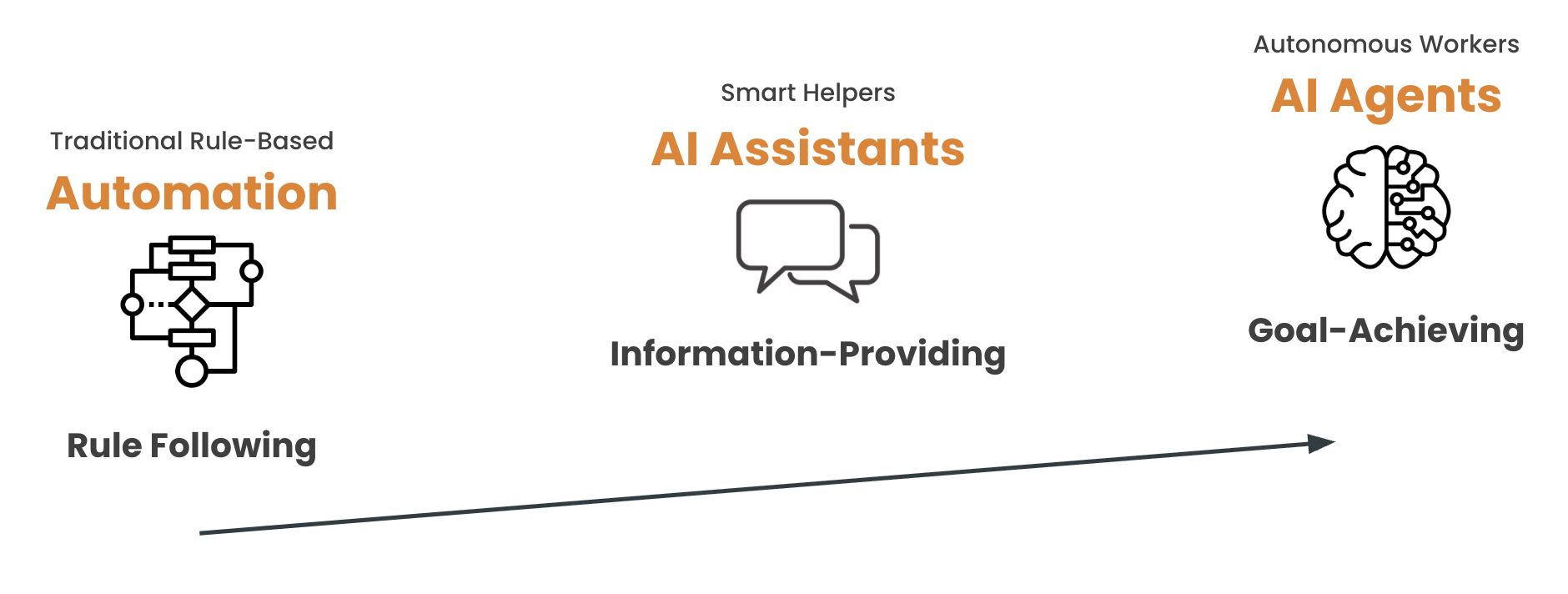AI Agents & Tools: Unlocking Enterprise Intelligence
Artificial Intelligence is no longer limited to answering questions or generating text. The next frontier is autonomy. AI agents are emerging as a powerful class of systems that can reason, take action, and complete tasks independently, often using your internal tools, data, and workflows.
At NorthBound Advisory, we’re helping organizations make sense of this shift. This post outlines the core components behind AI agents, how they differ from chatbots and assistants, and what it takes to deploy them successfully inside your business. More importantly, it shows why process design must come first to ensure real value.
From Chatbots to Autonomous Action: Why LLMs Aren’t Enough
Large Language Models (LLMs) like ChatGPT are impressive in their ability to understand and generate language. But on their own, they have critical limitations:
No real-world actions — They cannot send emails, update databases, or trigger workflows
No access to your proprietary data — They know nothing about your customers, systems, or operations
No persistent memory — They lose context between interactions
In other words, LLMs are great at interpreting language, but they are isolated from your systems and unaware of your business. To unlock true enterprise value, we need something more.
What Is an AI Agent?
AI agents extend LLMs with real-world utility. They combine reasoning, memory, and tool usage to complete complex tasks with minimal supervision.
An AI agent includes:
LLM (The Brain): Interprets language, plans tasks, and communicates results
Tools (The Hands): Executes actions using APIs, databases, CRMs, and SaaS systems
Memory (The Knowledge): Retains context across steps and sessions, and retrieves relevant information when needed
The Three Pillars of AI Agents
This combination makes agents far more than chatbots. They are autonomous actors, capable of working through business logic, accessing your internal data, and taking action on your behalf.
From Smart Helpers to Autonomous Workers
AI has evolved beyond fixed automation and smart assistants. Consider the shift:
Evolution of AI Systems - from rules to reasoning
AI agents act more like executive assistants. They take a high-level goal, figure out the steps, use tools to execute those steps, evaluate results, and adjust their actions as needed.
The Agentic Loop: How Agents Think and Act
AI agents operate through a structured reasoning cycle:
Perceive and Understand your request
Plan and Reason through how to achieve it
Act using tools to interact with your systems
Observe and Reflect on what the tools return
Iterate until the task is complete
Respond with a result or outcome
The Agentic Loop - How Agents Think & Act
This loop allows agents to adapt to changing input, incomplete data, or evolving priorities.
Tools: The Agent’s Link to the Real World
An agent’s intelligence is only useful if it can act. That’s where tools come in.
What are tools for agents?
Tools are external functions the agent can call to interact with your environment. They allow agents to:
Send messages or emails
Query databases
Trigger workflows or automations
Access proprietary data like CRM records, ERP systems, or knowledge bases
Standardizing Connections with the Model Context Protocol (MCP)
As agents connect to more systems, complexity grows. Direct integrations across every service create a combinatorial explosion of risk and maintenance effort.
The Model Context Protocol (MCP) addresses this by standardizing how AI agents interface with enterprise systems. Think of it as a universal connector, similar to USB-C, but for AI.
The MCP Protocol explained
MCP enables:
Secure, auditable access to business data
Simplified integration architecture
Reduced duplication and siloed logic
Scalable deployment of AI systems across departments
Memory and Smart Knowledge Retrieval
One of the biggest challenges in AI deployment is giving agents access to the right information at the right time. This is where memory and retrieval come in.
Agents use:
Document Chunking: Breaking documents into smaller units like paragraphs or sections
Vector Embeddings: Turning each chunk into a semantic fingerprint
Vector Databases: Storing and retrieving the most relevant chunks based on meaning
Retrieval-Augmented Generation (RAG): Merging retrieved content with the LLM’s own reasoning to generate accurate, contextual responses
This architecture removes the “I don’t know about your company” limitation and gives agents meaningful, real-time access to institutional knowledge.
The Real Lesson: Process Before Tools
This is where many projects go wrong. The tech is compelling, but if your internal process is broken, agents will simply automate failure.
A hard Lesson Learned: Process Before Tools
At NorthBound Advisory, our approach always starts with the flow:
Map the full process across departments
Identify where value is blocked, not just where tools are missing
Anchor everything to real KPIs — quote turnaround, invoice cycles, lead conversion, margin per order
Ask the right questions — Where are decisions slow or inconsistent? Where is visibility poor?
Only then is it time to deploy agents.
What AI Agents Can Unlock for Your Business
When built on the right foundation, agents enable:
Cost reduction by minimizing manual effort and rework
Operational efficiency through 24/7 automation
Strategic focus by freeing human talent for high-value initiatives
Scalability by automating complex processes at enterprise scale
Agents are a natural next step for organizations already investing in automation, analytics, and AI. They bring all three together to create real-time, goal-driven intelligence.
What Could You Automate?
Our clients are using AI agents to
Monitor and analyze support calls
Flag gaps in sales pipelines and trigger follow-ups
Summarize large volumes of emails or meeting transcripts
Automate scheduling, document classification, and workflow handoffs
The use cases are expanding quickly. What could your organization accomplish if your systems could reason, act, and improve over time?
If you’re exploring AI adoption and want to start in the right place, we’d be happy to have a conversation.
To explore this topic a bit deeper, checkout a 8-minute Podcast from Rick and Amanda as they explore this Blog in greater depth.






